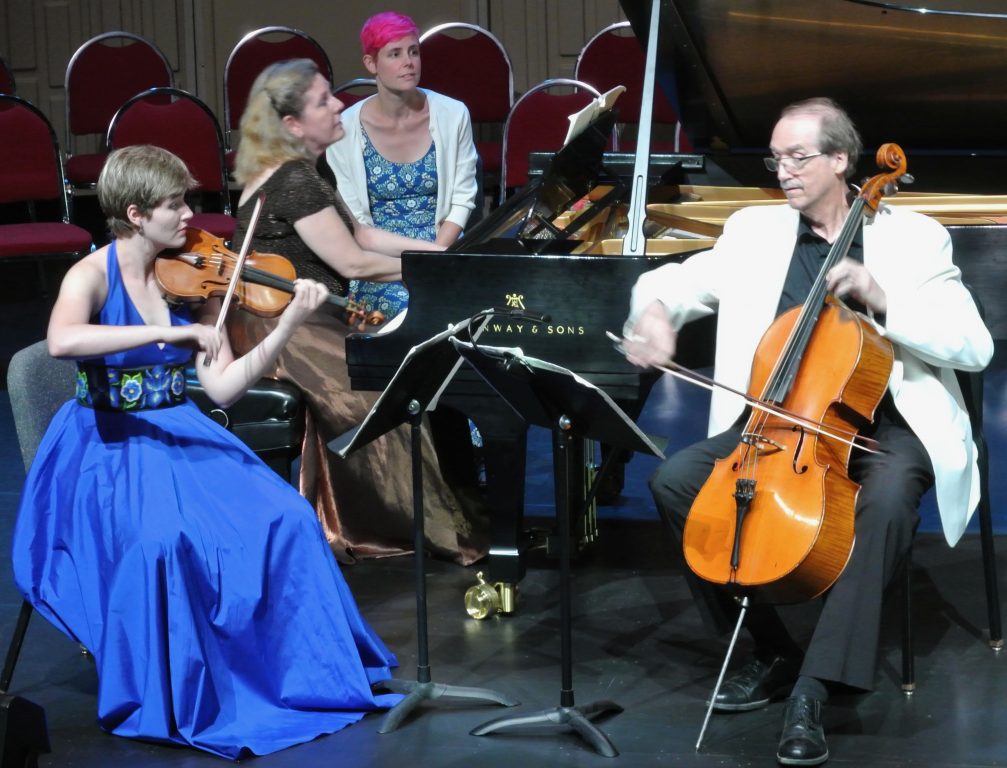Prometheus Trio Concert Is a Family Affair
Father, mother and daughter perform Beethoven, Brahms and Gabriela Lena Frank.

L to R: Emmy Tisdel Lohr, Stefanie Jacob, Scott Tisdel with Meaghan Heinrich in the back. Photo courtesy of Stefanie Jacob.
The Prometheus Trio might be named the Tisdel Trio twice this season. Daughter violinist Emmy Tisdel Lohr joins her parents, cellist Scott Tisdel and pianist Stefanie Jacob next Monday evening for a pair of significant “first trios” composed by Ludwig Van Beethoven and Johannes Brahms. They will also play a contemporary work by Gabriela Lena Frank. Lohr, now a member of the Tucson Symphony Orchestra, will return for a concert in April 2025.
The Trio in E-flat Major, Op. 1, No. 1 (1793-94) marks Beethoven’s debut in Vienna after his move to the city, where he quickly established himself as a notable pianist and caught the attention of the nobility who would support his career. Although he had composed numerous pieces before, Beethoven selected the set of three trios in Opus 1 to be his first published work, signaling the beginning of his public career. He introduced these trios at a meticulously organized event designed to showcase his innovative approach and solidify his standing in the Viennese music scene.
The trio builds beyond the classical gallant tradition established by Joseph Haydn (who attended the premiere), adding Beethoven’s personal stamp. The trio is in four movements rather than three. The first movement incorporates a melodic figure characterized by upward-rushing broken chords popularized as “Mannheim Rockets.” Rather than only offering harmonic support, the cello emerges as a full partner in an adagio section. A lively scherzo and energized presto finale replace the more usual minuet and dance movements. The energy of the trio comes with the rapid rhythmic phrases that catch one’s attention and tie the work together.
Frank (1972) was born in the United States but has been directly influenced by her parent’s cultures. Her father is of Lithuanian Jewish heritage, and her mother comes from a Peruvian/Chinese background. For the composer, “contemporary” music is less an exploration of instrumental sounds that have not been heard before than a synthesis of traditional cultural sources (primarily Peruvian) and the traditional instruments and structure of Western classical music. “I think the music can be seen as a by-product of my always trying to figure out how Latina I am and how gringa I am,” Frank has noted.
Few living composers are as accomplished. Frank has been sought out by a wide variety of accomplished performers, ensembles, and orchestras to write new works. She has collaborated with dozens of orchestras – including many residencies. She has sought opportunities to support others – culminating in a retreat-based program for other composers, the Gabriela Lena Frank Creative Academy of Music. See this Wikipedia article for the lengthy list of honors and compositions.
The Prometheus Trio will play Four Folk Songs for Piano Trio (2012). Quite different subjects and styles are represented: imagining Peru’s María Angola church, a colonial Spanish church in a highland setting; children playing in the streets, with Peruvian toys such as wooden llamas and shakers; a serenade inspired by the ubiquitous guitar/charango-vocalist duo; and recognition of Perú’s pre-Inca past by evoking the sounds of an isolated, warlike yet artistically creative culture, Chavín de Huantar.
Brahms’ revised Piano Trio No. 1 in B Major, Op. 8 (1854, revised 1891) showcases the composer’s mature style while retaining his youthful creativity. The four-movement work opens with an Allegro con brio, featuring a serene melody that unfolds from the piano to a passionate hymn-like passage involving all instruments. This movement exemplifies Brahms’ blend of lyricism and rhythmic vitality. The Scherzo contrasts a light, Mendelssohn-like opening with sudden ferocious turns. The Adagio third movement is deeply expressive, with a beautiful cello melody and poignant piano response. And the finale features a main theme with Hungarian influences. Brahms builds tension throughout, culminating in a powerful, stormy conclusion that leaves the work in a minor key – unusual for a piece that began in a major key.
Don’t be misled by the label “first trios.” Haydn and others praised Beethoven’s debut effort as a mature work. Brahms’s first version of his trio at age 20 was refined by him 37 years later. For that matter, Frank was well into an honored and productive career when she wrote Four Folk Songs. (Click on each of the composition names to preview a selection on YouTube.)
The concert Monday, Dec. 2 at 7:00 p.m., will be presented in the Helen Bader Recital Hall at the Wisconsin Conservatory of Music, 1584 N. Prospect Ave. Tickets may be purchased online or at the door. Complimentary parking is available at Milwaukee Eye Care, 1684 N. Prospect Ave., one block north of the Conservatory.
The Prometheus Trio will perform their next concert on Feb. 17, 2025, featuring a piano trio by Franz Schubert and another by contemporary composer Kevin Puts. Guest violinist Yuka Kadota will join Jacob and Tisdel.
If you think stories like this are important, become a member of Urban Milwaukee and help support real, independent journalism. Plus you get some cool added benefits.
Preview
-
A Sacred Choir, 70 Voices Strong
 Dec 14th, 2025 by Martha Brown
Dec 14th, 2025 by Martha Brown
-
Prometheus Trio Goes Bohemian
 Dec 3rd, 2025 by Martha Brown
Dec 3rd, 2025 by Martha Brown
-
Present Music Offers New Choral Works
 Nov 20th, 2025 by Michael Barndt
Nov 20th, 2025 by Michael Barndt




















